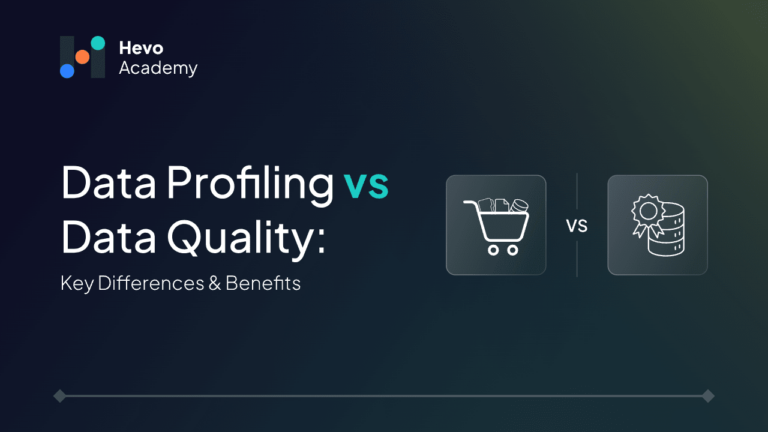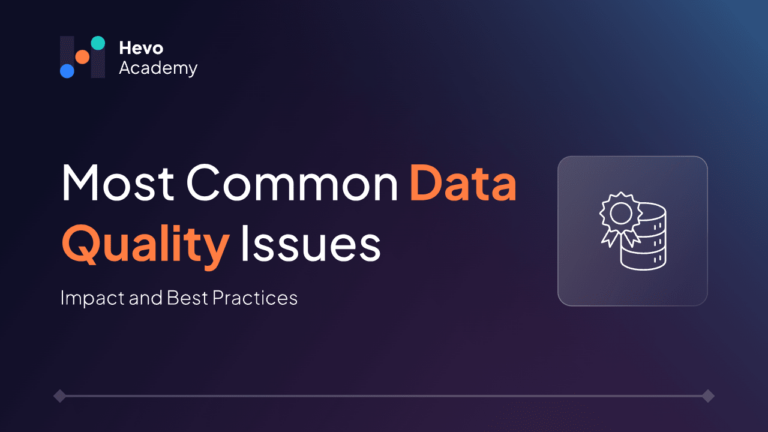Data is a collection of facts, statistics, or information. It can be in any format, such as images, text, or even numbers ( quantitative or qualitative), which can be used for analysis. Data comes from various sources, including transactions, web platforms, social media, IoT devices, and public data. In today’s data-driven world, having high-quality data is essential, as it helps organizations to make informed strategies and enhance customer satisfaction. A Gartner research estimates that poor data quality costs organizations an average of $12.9 million per year, which leads to financial loss, resources, and time.
Table of Contents
Organizations rely on data quality rules such as accuracy, consistency, uniqueness, completeness, integrity, validity, and timeliness. Inaccuracies in data can lead to poor strategic decisions, costly errors, and missed opportunities. This is where Data Quality Management (DQM) comes into the scene.
Data Quality Management includes a wide range of practices and processes designed to ensure that data is reliable and consistent. The DQM framework helps businesses transform data into a reliable and strategic asset, implementing systematic processes for data profiling, cleansing, and monitoring information. In this blog, we will explore why the DQM framework is important, what are the key components of DQM, what benefits and best practices, and also about how important it is Big Data analytics to improve overall efficiency.
What is Data Quality Management?
Data Quality Management is a systematic approach with a set of tools, practices, and capabilities that ensures the data is accurate, reliable, and consistent for business-related analysis. These practices enable organizations to identify and resolve data-related issues and deliver high-quality data to users.
What are the main core components of Data Quality Management?
Data Quality Management contains several components essential for maintaining high data consistency and accuracy standards. These components help identify and resolve all data quality issues to ensure reliable data to end users.
1. Data Profiling
- Explore and analyze existing data structure, quality, data types, patterns, inconsistencies, errors, and missing values.
- Data profiling helps to gain insights from the data and make informed decisions about areas for improvement.
- It also ensures that data is accurate, complete, and suitable for its intended purpose, enhancing data quality.
- Example: A retail company analyzes its customer demographic pattern. By profiling, they found that 40% of their customer email addresses are missing. They implemented a data cleansing initiative to fill these gaps. Some popular tools for data profiling include Talend Data Quality and Microsoft SQL Server Data Quality Services (DQS).
2. Data Governance
- The overall data governance framework establishes standards, policies, and procedures to develop a structured approach for managing data quality.
- Defines roles and responsibilities for data stewardship for overseeing data quality and governance practice.
- Protecting customers’ sensitive information from unauthorized access and ensuring compliance with regulations such as the General Data Protection Regulation (GDPR) or the Health Insurance Portability and Accountability Act (HIPAA).
- Tools such as IBM Watson Knowledge Catalog offer robust governance frameworks, such as Microsoft Purview, Collibra, etc.
3. Data Cleansing
- Data Cleansing involves removing duplicates, correcting inaccuracies and updating data to improve high quality.
- In customer relationship management, clean data can help personalized marketing strategy, encourage customer satisfaction and improve higher conversion rates.
- Detecting and addressing outliers, which may indicate errors or unusual trends.
- Tools: Data Ladder DataMatch, IBM Watson Studio.
4. Data Integration
- It combines data from different sources in an organization to a unified view.
- Data integration helps in overcoming data silos – It refers to the data storage that contains information that is not easily accessible within an organization.
- Integration in real-time allows organizations to access up-to-date information.
- Data integration tools include Hevo Data, Microsoft Azure Data Factory(a cloud-based data integration platform), and Informatica PowerCenter.
5. Data Validation
- Establishing specific rules that data must meet to be considered valid. This includes range checks, logical validations, format checks, and uniqueness checks.
- Cross-reference happens to ensure its consistency across different datasets.
- IBM Watson Data Refinery, Talend Data Quality are popular data validation tools.
6. Data monitoring
- Data monitoring involves continuously observing data quality metrics and tracking data trends over time.
- Alert stakeholders about data quality issues using automated data monitoring tools.
- Use Apache Kafka, Prometheus, and Google Cloud Monitoring tools to track data flows, performance, and anomalies in real-time.
By implementing these core components, organizations can build a robust Data Quality Management system that improves data reliability and supports informed decision-making.
What are the Benefits of Effective Data Quality Management?
Effective DQM has an impact on an organization. Good data allows businesses to optimize productivity and boost customer satisfaction.
- Enhanced Decision-Making: It refers to the ability of an organization to make well-informed decisions based on high-quality data. The main purpose of achieving high-quality data is to eliminate uncertainties, which further helps organizations to analyze the data and compare it with current trends. When data is reliable and consistent, it helps organizations to make informed choices, reducing financial loss and improving performance of the organization.
- Overall Operational Efficiency: The main purpose of maintaining a high operational efficiency strategy is to maximize profitability and productivity. By streamlining processes, businesses can reduce costs associated with allocating resources, which results in higher outcomes and quick response to technological advancements. When data quality procedures are clear, it is easy to improve an organization’s overall performance.
- Improved Customer Relationship: Incomplete data can lead to significant issues such as wrong customer addresses,shipping errors, and poor customer service experiences. If organizations do not actively address these issues, they can damage their reputation and customers’ trust in them.
- Regulatory Compliance and Risk Mitigation: DQM helps organizations maintain high-quality data to protect sensitive information and avoid legal penalties, reputational damages, and data threats.
- Better Insights: Businesses that prioritize high-quality data can drive better data, analyze outcomes, accelerate innovation, and respond more effectively to market changes.
- Boost Productivity: When the data is clean and reliable, employees spend less time cleansing and validating it. This effectively improves productivity time, allowing employees to focus on value-added tasks. It also allows a smoother, streamlined workflow, reduces bottlenecks, and enhances efficiency.
- Prepared to Deal with Environment Changes: Organizations with high-quality data are prepared to change and adapt more quickly to new trends and technologies effectively.
Best Practices of Data Quality Management
- Implement Data Quality Management: Establish a framework or procedure that prioritizes data quality, accuracy, and reliability. It should define data governance roles, data profiling, and regular data quality audits. By implementing automated tools for data cleansing and validation, companies reduce human error, such as wrong data entry, typographical errors, duplicate entries, and missed data.
- Accountability of Data Integrity: It is an important practice of DQM. By developing a culture of data stewardship, the organization encourages employees to understand the importance of their roles and responsibilities. This approach creates an impact among the team members, ensuring that everyone understands their responsibilities to achieve data quality and integrity. This act improves the overall data management strategy among team members.
- Automated Tools: Investing in data quality automated tools to automate tasks, track processes and control errors. Data dictionary tools complement automated data quality tools by providing a centralized repository of metadata, ensuring consistency and clarity in data definitions across systems.
Why is Data Quality Management Important for Big Data?
Big Data plays an important role in improving Data Quality Management by providing advanced tools, technologies and methodologies for data integrity and analysis. Today’s organizations leverage the 3 V’s of big data such as volume, variety, and velocity to gain deeper insights into data-related issues. Furthermore, big data analytics facilitates an easy data integration of various datasets into an unified view that enhances overall data consistency. Here it shows how DQM is important for Big Data:
- Scalable data processing: DQM frameworks such as Hadoop, Spark are designed to handle large volumes of data, which helps to maintain data scalability.
- Real-time monitoring: With Big Data, DQM monitoring tools are implemented to monitor data integrity and accuracy.
- Advanced Analytics and Machine Learning: DQM utilizes ML algorithms to predict data patterns, identify trends, and anomalies, and automate data processing tasks.
However, managing big data with DQM comes with challenges. Managing a very large volume of data makes it difficult to identify errors. Additionally, Big Data originates from different sources, each has its own unique formats that complicate data management. Furthermore, adapting to the variety of data formats is essential for seamless integration and analysis.
Conclusion
In today’s data-driven landscape, effective Data Quality Management (DQM) is essential for organizations striving to make informed decisions and enhance customer satisfaction. By focusing on critical dimensions such as accuracy, completeness, and consistency, DQM transforms data into a reliable asset. Implementing core components like data profiling, cleansing, integration, and monitoring mitigates errors and streamlines operations. As businesses leverage Big Data’s volume, velocity, and variety, a robust DQM framework becomes vital for maintaining high-quality data. Ultimately, investing in DQM empowers organizations to optimize productivity, boost customer trust, and adapt swiftly to changing market dynamics.
Sign up for a 14-day free trial and experience the feature-rich Hevo suite first hand. Check out the Hevo pricing details.
FAQ
1. What are the 6 C’s of data quality?
– Completeness: Ensure all data are present without any missing values.
– Consistency: Maintains a uniform format.
– Correctness: Refers to the true-value of data.
– Currency: Up-to-date data information and relevant for analysis.
– Conformity: Follows pre-defined format and standards, for easy integration.
– Coverage: Refers to the extent to which data represents desired context, ensuring that the dataset is comprehensive enough for analysis.
2. What are the 5 V’s of data quality?
– Volume: Refers to the amount of data generated, stored, which can affect the ability to maintain data quality.
– Velocity: The speed at which data is processed for assessment and actions.
– Variety: Structure, unstructured and semi-structured data format, integrated to analyze data consistency.
– Value: It provides meaningful insights and supports decision-making processes.
– Veracity: Trustworthiness and accuracy of data.
3. What are the 7 dimensions of data quality?
– Accuracy:The degree to which data correctly represents the real-world entities or events it describes.
– Completeness: Ensure no missing data is present.
– Consistency: Maintains uniform format across datasets, ensuring data value does not conflict.
– Timeliness: Up-to-date and available data when needed.
– Validity: The extent to which data meets the defined business rules or constraints, ensuring it is acceptable for its intended use.
– Uniqueness: Ensure whether the data is distinct.
– Accessibility: The ease with which data can be assessed and retrieved by users.





